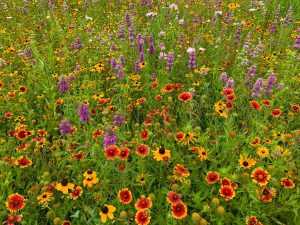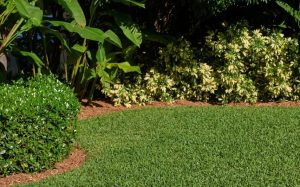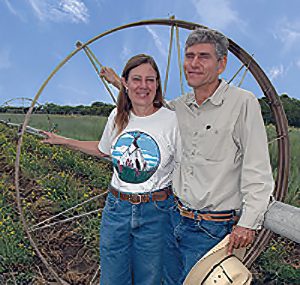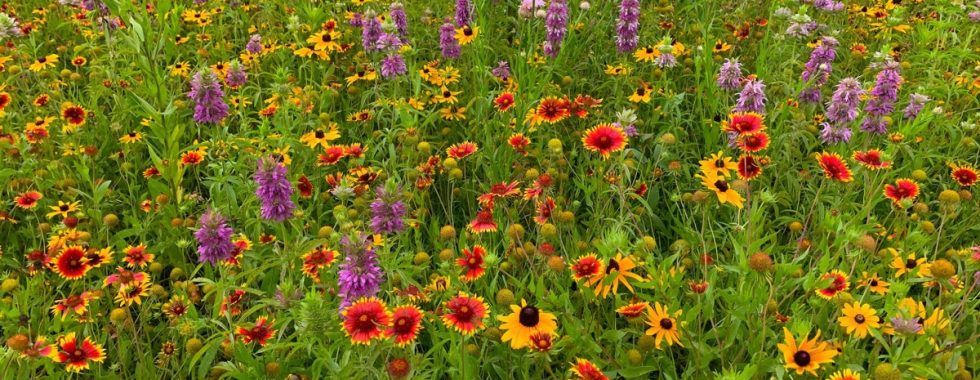Looking to Re-Wild Your Yard and Stray from St. Augustine Grass? Native American Seed Is Here to Help!
 As we learn more about living mutualistically with nature, we find an increasing number of things in our lives that we need to change. In the 1960s, for example, the world learned about CFCs in hairspray and what those chemicals were doing to our ozone layer. So, in 1987, 197 countries banded together to sign the Montreal Protocol, removing chlorofluorocarbons from household products. In the 1970s DDT was outlawed in the U.S. after environmental scientists, chiefly Rachel Carson in her momentous Silent Spring, exposed the pesticide’s bioaccumulation in wildlife. These success stories are encouraging to witness, but they can also have a negative effect on those of us who feel like they can’t produce change in such a dramatic way. As an antidote to discouragement, I find it helpful to think about this statement by Dr. Jane Goodall: “The saying, ‘Think globally, act locally’ – turn it around. Think locally, then you have the courage to act globally. If you only think globally to start with, you won’t have the energy to act.”
As we learn more about living mutualistically with nature, we find an increasing number of things in our lives that we need to change. In the 1960s, for example, the world learned about CFCs in hairspray and what those chemicals were doing to our ozone layer. So, in 1987, 197 countries banded together to sign the Montreal Protocol, removing chlorofluorocarbons from household products. In the 1970s DDT was outlawed in the U.S. after environmental scientists, chiefly Rachel Carson in her momentous Silent Spring, exposed the pesticide’s bioaccumulation in wildlife. These success stories are encouraging to witness, but they can also have a negative effect on those of us who feel like they can’t produce change in such a dramatic way. As an antidote to discouragement, I find it helpful to think about this statement by Dr. Jane Goodall: “The saying, ‘Think globally, act locally’ – turn it around. Think locally, then you have the courage to act globally. If you only think globally to start with, you won’t have the energy to act.”
 A case in point. In the last two years I have learned a good deal about xeriscaping and the ecological nightmare of St. Augustine grass. Hill Country Alliance and Native American Seed put together a PDF fact sheet in 2012 about the horrors of St. Augustine grass which can be found by searching for the title “St. Augustine Water Conservation in the Texas Hill Country.” Some of the more hard-hitting stats from the article:
A case in point. In the last two years I have learned a good deal about xeriscaping and the ecological nightmare of St. Augustine grass. Hill Country Alliance and Native American Seed put together a PDF fact sheet in 2012 about the horrors of St. Augustine grass which can be found by searching for the title “St. Augustine Water Conservation in the Texas Hill Country.” Some of the more hard-hitting stats from the article:
- “In 2011, a single 2,000 sq ft sized St. Augustine lawn in New Braunfels required an additional 72,430 gallons over the growing season to match the 65 inches per year the grass would normally receive in its evolutionary native habitat on the Atlantic coastline.”
- “The World Water Council found that the average American uses 158.5 gallons of water per day, ranking the highest usage in the world. Europeans rank second using between 66 and 92 gallons per day. The minimum basic standard is 13 gallons per day. Americans use over twelve times more than the basic standard, with the majority being applied to our landscapes. (“Global Researcher” 31)”
 “St. Augustine grass is not native to the Texas Hill Country; it provides nearly no ecological benefit. Plants are the only species on the planet that can capture the sun’s energy and turn it into food. Therefore, plants are the foundation of the entire world’s food chain. Every animal gets its food either directly from eating plants or from eating something that has eaten a plant. Central Texas is known for abundant native wildlife, but the native fauna has no long-term evolutionary exposure to St. Augustine. When alien plants are introduced into the landscape, they displace native plants. Local and/or migratory wildlife often have no use for alien plants. For example, if a monarch butterfly cannot locate a host milkweed to lay its eggs upon, she cannot simply move over to petunias. Her larvae, in the caterpillar stage, are only adapted to survive on the dwindling number of Asclepias (milkweed) species. All songbirds feed insects to their young. Insects are highly selective and have evolved to feed on specific plant species. If food is not available, wildlife moves on or eventually life does not continue (Tallamy, “Bringing Nature Home” 20).”
“St. Augustine grass is not native to the Texas Hill Country; it provides nearly no ecological benefit. Plants are the only species on the planet that can capture the sun’s energy and turn it into food. Therefore, plants are the foundation of the entire world’s food chain. Every animal gets its food either directly from eating plants or from eating something that has eaten a plant. Central Texas is known for abundant native wildlife, but the native fauna has no long-term evolutionary exposure to St. Augustine. When alien plants are introduced into the landscape, they displace native plants. Local and/or migratory wildlife often have no use for alien plants. For example, if a monarch butterfly cannot locate a host milkweed to lay its eggs upon, she cannot simply move over to petunias. Her larvae, in the caterpillar stage, are only adapted to survive on the dwindling number of Asclepias (milkweed) species. All songbirds feed insects to their young. Insects are highly selective and have evolved to feed on specific plant species. If food is not available, wildlife moves on or eventually life does not continue (Tallamy, “Bringing Nature Home” 20).”
 This leads me to our collective solution as stewards of our beloved Texas Hill Country, a solution that is much, much easier than you think. Located a mere 8 miles from the old San Marcos Courthouse is a magical buildings that too few people know about. The large warehouse is a distribution center for a company doing some of the most good in our state, Native American Seed. The company was founded in 1989 by Jan and Bill Neiman, whose aim is to bring native plants back to their local bioregions. Their website offers a slew of advice for folks who are new to the re-wilding lifestyle, spotlights for all their employees (I recommend reading through each person’s profile; to say they’re heartwarming is an understatement!), individual consulting services, resources for teachers to use in their classroom, and even two cabins you can rent on their property next to the Llano River in Junction. Every link on their website opens a door to a beautiful opportunity to learn about your place in nature. It is undeniable that the Neimans’ impact on the Texas ecosystem through offering education and providing seeds of native plants is quite large, but there is still much land in our state that has yet to be rehabilitated, especially urban lawns.
This leads me to our collective solution as stewards of our beloved Texas Hill Country, a solution that is much, much easier than you think. Located a mere 8 miles from the old San Marcos Courthouse is a magical buildings that too few people know about. The large warehouse is a distribution center for a company doing some of the most good in our state, Native American Seed. The company was founded in 1989 by Jan and Bill Neiman, whose aim is to bring native plants back to their local bioregions. Their website offers a slew of advice for folks who are new to the re-wilding lifestyle, spotlights for all their employees (I recommend reading through each person’s profile; to say they’re heartwarming is an understatement!), individual consulting services, resources for teachers to use in their classroom, and even two cabins you can rent on their property next to the Llano River in Junction. Every link on their website opens a door to a beautiful opportunity to learn about your place in nature. It is undeniable that the Neimans’ impact on the Texas ecosystem through offering education and providing seeds of native plants is quite large, but there is still much land in our state that has yet to be rehabilitated, especially urban lawns.
If Native American Seed’s mission of “helping people restore the Earth” sounds as enticing to you as it does to me, you can visit their website at www.seedsource.com to order a variety of native seeds. Under the tab “Shop for Natives” you’ll find links that take you to Native Wildflowers, Native Grasses, Native Seed Mixes, or Live Roots. They also have a search option if you know what you’re looking for either by the common name or the botanical name. Here is where you can book an ecotourism package, buy your favorite books, purchase planting or erosion equipment, and find gifts as well. We’re approaching the best time of year to plant for most Texas flora, so you’ll want to check out the tab “Planting Tips” on the top of their site, which talks you through planting seeds in the Fall. Basically, everything you need to be a good steward of the Hill Country is laid out in the finest of detail through Native American Seed’s website!
So happy shopping! You can buy from their website but opt to pick up locally at their warehouse on I-35 just outside of town to skip the shipping. Cheers to a lovely fall of planting so we can all enjoy some wildflowers and grasses come spring!
Written by Lauren Chappell, SMGA Outreach Committee member and Texas State University graduate student in aquatic biology.


